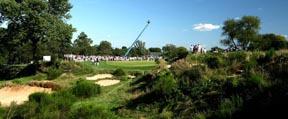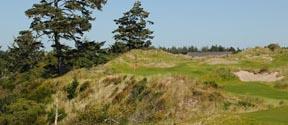(Golfweek architecture editor Bradley Klein talks a walk through seven courses around the world that broke the mold in 2012.)
It would be nice to be able to tie a thematic ribbon around golf course architecture and summarize a whole year in review with a catchy phrase. The slow pace of design, development, permitting, construction and grow-in render such pronouncements a bit forced and artificial. And yet there are ways to handpick certain moments of the past year as if they were road markers on a longer journey.
There's no doubt that a common theme throughout the U.S. for 2012 was a new realism in golf course design and operations, with many facilities taking a closer look at budgets and trying to simplify maintenance. The more pragmatic approach extends to tee placement and playing yardages for average golfers more and more of whom are setting out at 6,200-6,400 yards (for men) rather than flexing their imaginary muscles and trying to take on courses at 7,000 yards or more.
Equally comforting is to see many courses actually shortening their forward tee markers so that the most frequent users of them (it's not a violation of PC norms to observe empirically that most such players from these tees are women) are playing more often at 4,800-5,200 yards rather than at 5,600-6,000 yards. So for all the emphasis of late on the ball going farther than ever, the real trend is that courses are getting more varied in length both longer and shorter.
We're also hearing from architects more of an emphasis on strategic variety to the point where courses now regularly include "half-par" holes and that in either direction. So we are seeing more very short par 3s, drivable par 4s and risk-reward reachable par 5s. At the same time, we're seeing more excessively long holes per each category of par: the 250-plus-yard par 3, the 500-yard par 4 and the 600-plus-yard par 5.
Merion Golf Club (East)
 Curiously, the best example of this trend is the layout that has now been meticulously groomed for the 2013 U.S. Open: Merion Golf Club's East Course, whose current routing turned 100 in 2012, in Ardmore, Pa.
Curiously, the best example of this trend is the layout that has now been meticulously groomed for the 2013 U.S. Open: Merion Golf Club's East Course, whose current routing turned 100 in 2012, in Ardmore, Pa.
The course I saw this summer has been stretched, shaved, narrowed and contorted a bit. For obvious reasons, the USGA has opted to keep it under 7,000 yards (6,996 yards, to be exact) to make a point about it still being relevant in an era of 300-yard drives. But what a contrast of long and short it will be, with two par 3s of 250-plus-yards, two par 4s measuring 504-505 yards, and an unreachable (in two) par 5 of 633 yards where the new back tee sits in the left rough of an adjoining hole. All of that comes in the beginning and end of a layout where there's a seven-hole stretch, from the Nos. 7 through 13, with no hole longer than 403 yards.
Bandon Preserve
If seven holes work so well, how about 13? That's the idea behind the latest and surely last golf course development on the site of the Bandon Dunes Resort in Oregon.
 Bandon Preserve, a par-3 layout of 13 holes, is a new Bill Coore-Ben Crenshaw design that nestles into lovely ocean-facing dunes between the first hole of Bandon Trails and the 17th hole of the original Bandon Dunes course. Holes range from 87 to 150 yards, and there's just as much TLC devoted to the shaping of these wild greens and scruffy, Riviera-style bunkers as anything this duo has ever done. The result is a frolicking, scenic venue for a late-afternoon emergency nine. It's ideal for drunken betting on wind-blown shot-making, a skill enabled by some amazing margaritas that seem to appear as if served from a bunker - a building, not sand trap astride the fourth tee and again as you get to the eighth hole.
Bandon Preserve, a par-3 layout of 13 holes, is a new Bill Coore-Ben Crenshaw design that nestles into lovely ocean-facing dunes between the first hole of Bandon Trails and the 17th hole of the original Bandon Dunes course. Holes range from 87 to 150 yards, and there's just as much TLC devoted to the shaping of these wild greens and scruffy, Riviera-style bunkers as anything this duo has ever done. The result is a frolicking, scenic venue for a late-afternoon emergency nine. It's ideal for drunken betting on wind-blown shot-making, a skill enabled by some amazing margaritas that seem to appear as if served from a bunker - a building, not sand trap astride the fourth tee and again as you get to the eighth hole.
2016 Olympic Course
One thing we found in 2012 is that inventive half-par holes, scruffy set-ups and fun, walkable golf is not just a gourmet's niche. Or perhaps it might have seemed it was, until one of the leading proponents of such design, Gil Hanse, beat out the likes of Jack Nicklaus, Greg Norman and Gary Player for the most plum assignment of the year, the 2016 Olympic Course in Rio de Janeiro. His winning plan included half-par holes, an efficiently walkable layout and environmentally sensitive grasses and maintenance. To be honest, most of the finalists (who also included Tom Doak, Martin Hawtree, Robert Trent Jones Jr. and Peter Thomson) had similar elements of inventive links-inspired design in their proposals. What might have put Hanse over the top was his commitment to moving to Rio to build the course no small promise in a place where land disputes are likely to drag out the construction process for a frighteningly long time.
Trump International Golf Links Scotland
 Hawtree didn't need the Rio contract to make his year. He made news in July with the debut of his Trump International Golf Links Scotland in Aberdeen. With Donald Trump providing press coverage and his management team successfully tacking its way through the Scottish regulatory bureaucracy, Hawtree was free to make the towering dunes of the old Menie Estate north of the countrys oil capital into manageable ground for golf. That he succeeded at all is a testament to his skill and Trump's considerable ambition. Plans for a lavish five-star resort and accompanying real estate are next in line.
Hawtree didn't need the Rio contract to make his year. He made news in July with the debut of his Trump International Golf Links Scotland in Aberdeen. With Donald Trump providing press coverage and his management team successfully tacking its way through the Scottish regulatory bureaucracy, Hawtree was free to make the towering dunes of the old Menie Estate north of the countrys oil capital into manageable ground for golf. That he succeeded at all is a testament to his skill and Trump's considerable ambition. Plans for a lavish five-star resort and accompanying real estate are next in line.
The full strength and character of any course take years to develop and draw a following; for now, only six months after opening, its fair to say that Trump International Aberdeen is a magnificent piece of modern golf, with great variance in playing character due to amply staggered tees. If it lacks a little in the element of playful recovery from wayward shots, it more than makes up for it in drama, beauty and the demands of focusing on each successive shot. There can be no more beautiful layout in all of Scotland to walk. With its opening in 2012, the Northeast coast has been elevated to the ranks of the country's premier golf destinations.
The Old Course at St. Andrews
 Hawtree made even more news in November, when the R&A prompted the St. Andrews Links Trust to announce significant tweaking to almost half the holes at The Old Course. The work was entrusted to Hawtree, who is now the designated tinkerer for the R&A Championship Committee in toughening up Open Championship layouts. On any other course, the magnitude of the tweaks to St. Andrews would not have aroused much controversy. But the Old Course is not like any other course; its routing and greens have been virtually unchanged for a century, the last bunker having been adjusted in the 1920s. And it has acquitted itself well enough in Open Championships when the wind blows. When it doesn't blow, St. Andrews, like any other links layout, is susceptible to birdies. Of course if the R&A, in conjunction with the USGA, had done a better job of monitoring the advances in playing equipment that threaten the integrity of classic courses, they wouldn't have to tinker with these museum-piece treasures.
Hawtree made even more news in November, when the R&A prompted the St. Andrews Links Trust to announce significant tweaking to almost half the holes at The Old Course. The work was entrusted to Hawtree, who is now the designated tinkerer for the R&A Championship Committee in toughening up Open Championship layouts. On any other course, the magnitude of the tweaks to St. Andrews would not have aroused much controversy. But the Old Course is not like any other course; its routing and greens have been virtually unchanged for a century, the last bunker having been adjusted in the 1920s. And it has acquitted itself well enough in Open Championships when the wind blows. When it doesn't blow, St. Andrews, like any other links layout, is susceptible to birdies. Of course if the R&A, in conjunction with the USGA, had done a better job of monitoring the advances in playing equipment that threaten the integrity of classic courses, they wouldn't have to tinker with these museum-piece treasures.
Cabot Links in Inverness, Nova Scotia
 Trump Scotland made blaring headlines when it debuted, Cabot Links in Inverness, Nova Scotia came on board at a very different end of the spectrum in tone, marketing and presentations. Up here on this remote western coast of Cape Breton Island, unheralded architecture veteran Rod Whitman has been working with owner/developer Ben Cowan-Dewar, with help from Mike Keiser of Bandon Dunes fame. You literally stumble upon the golf course in the middle of this sleepy old fishing village and find yourself on dramatic bluffs looking out into the Gulf of St. Lawrence. The bunker work is decidedly old school edgy, scruffy and half in the process of eroding, as wind and gravity do their natural work. The best holes sit on a little stretch to the west along MacIsaac's Pond, with the view down past the 11th fairway a virtual transplant of how Cruden Bay's famed par-3 fourth hole extends in front of that little fishing village of Port Erroll.
Trump Scotland made blaring headlines when it debuted, Cabot Links in Inverness, Nova Scotia came on board at a very different end of the spectrum in tone, marketing and presentations. Up here on this remote western coast of Cape Breton Island, unheralded architecture veteran Rod Whitman has been working with owner/developer Ben Cowan-Dewar, with help from Mike Keiser of Bandon Dunes fame. You literally stumble upon the golf course in the middle of this sleepy old fishing village and find yourself on dramatic bluffs looking out into the Gulf of St. Lawrence. The bunker work is decidedly old school edgy, scruffy and half in the process of eroding, as wind and gravity do their natural work. The best holes sit on a little stretch to the west along MacIsaac's Pond, with the view down past the 11th fairway a virtual transplant of how Cruden Bay's famed par-3 fourth hole extends in front of that little fishing village of Port Erroll.
At Cabot Links there are some stunning scenes, like the all-or-nothing drop-shot par-3 14th hole, 102 yards with the gulf forming an infinity edge and the ball buffeted by howling winds from somewhere. It'll take some adjusting to get used to the contrast of harshly modernist, pseudo-Bauhaus clubhouse and hotel structures presiding over such a folksy links tract as this. But there's good reason to think that Cabot Links can jump-start what ought to be a thriving tourist trade.
Black Jack's Crossing Golf Club
Black Jack's Crossing Golf Club in Lajitas, Texas, should be so lucky. The seemingly lyrical mantra of "build it and they'll come" is only valid if they can find it. Lajitas, a 42-square-mile resort, occupies a remote corner of southwest Texas' underbelly along the Rio Grande border with Mexico, abutting Big Bend National Park. Good thing this retro Old West frontier town, 400 miles west of San Antonio and 300 miles southeast of El Paso, has its own 5,000-foot-long paved runway. The par-72 golf course, designed by Lanny Wadkins and Paul Cowley, is stretchable to 7,413 but plays a whole lot more comfortable and accommodating at the three most forward tees, many of them benched into the rugged, barren hills. The holes amble up and down through rock canyons and across dry washes. This is strictly ride 'em, cowboy! golf, with little if any use in trying to walk, given the heat, elevation and aridity. For a year marked by a return to basics, here's proof that the golf market is big enough to accommodate many different styles. And besides, nobody would mistake this place for country-club lushness.
And for those with a hankering for the new global market, there's an opportunity here to strike a blow for international solidarity. And so I stood on the back tee of the par-4 15th hole, turned dead left, teed a ball up and drove it over the Rio Grande into Mexico.

